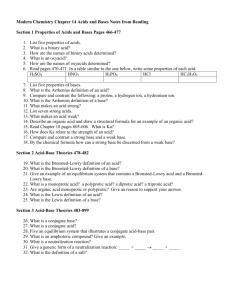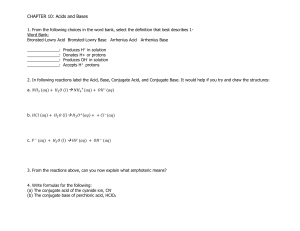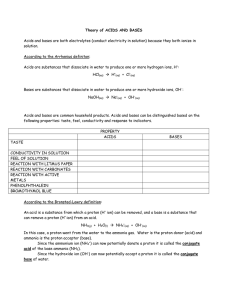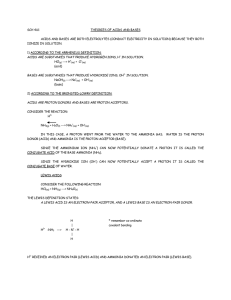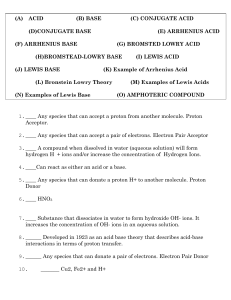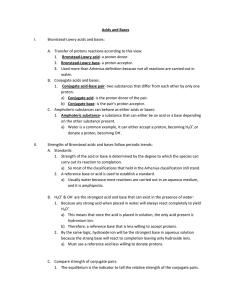Acid Base Theories: Arrhenius & Bronsted-Lowry Summary
advertisement
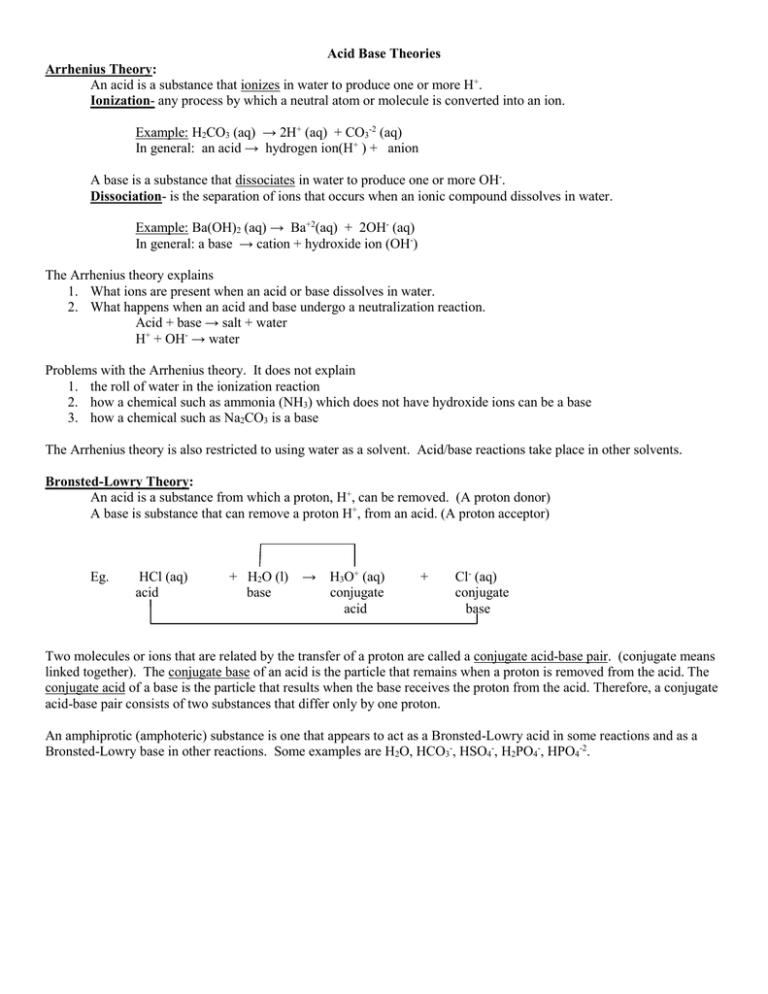
Acid Base Theories Arrhenius Theory: An acid is a substance that ionizes in water to produce one or more H+. Ionization- any process by which a neutral atom or molecule is converted into an ion. Example: H2CO3 (aq) → 2H+ (aq) + CO3-2 (aq) In general: an acid → hydrogen ion(H+ ) + anion A base is a substance that dissociates in water to produce one or more OH-. Dissociation- is the separation of ions that occurs when an ionic compound dissolves in water. Example: Ba(OH)2 (aq) → Ba+2(aq) + 2OH- (aq) In general: a base → cation + hydroxide ion (OH-) The Arrhenius theory explains 1. What ions are present when an acid or base dissolves in water. 2. What happens when an acid and base undergo a neutralization reaction. Acid + base → salt + water H+ + OH- → water Problems with the Arrhenius theory. It does not explain 1. the roll of water in the ionization reaction 2. how a chemical such as ammonia (NH3) which does not have hydroxide ions can be a base 3. how a chemical such as Na2CO3 is a base The Arrhenius theory is also restricted to using water as a solvent. Acid/base reactions take place in other solvents. Bronsted-Lowry Theory: An acid is a substance from which a proton, H+, can be removed. (A proton donor) A base is substance that can remove a proton H+, from an acid. (A proton acceptor) Eg. HCl (aq) acid + H2O (l) base → H3O+ (aq) conjugate acid + Cl- (aq) conjugate base Two molecules or ions that are related by the transfer of a proton are called a conjugate acid-base pair. (conjugate means linked together). The conjugate base of an acid is the particle that remains when a proton is removed from the acid. The conjugate acid of a base is the particle that results when the base receives the proton from the acid. Therefore, a conjugate acid-base pair consists of two substances that differ only by one proton. An amphiprotic (amphoteric) substance is one that appears to act as a Bronsted-Lowry acid in some reactions and as a Bronsted-Lowry base in other reactions. Some examples are H2O, HCO3-, HSO4-, H2PO4-, HPO4-2. Acids and Bases Summary Chart Acids Properties of acids water soluble electrolyte tastes sour not slippery to the touch turns blue litmus red pH<7 react with active metals to produce H2(g) react with carbonates to produce CO2(g) Bases Properties of bases water soluble electrolyte tastes bitter slippery to the touch turns red litmus blue pH>7 Acids can be both strong and weak. The strong acids are sulfuric acid, nitric acid, and hydrochloric. If 99% (or more) of an acid ionizes it is considered to be a strong acid. Strong acids will have a higher conductivity, a lower pH and a faster reaction rate than weak acids. If less than 50% of an acid ionizes it is considered to be a weak acid. Examples of weak acids are acetic acid, nitrous acid and carbonic acid Bases can be both strong and weak. All metallic hydroxides are considered to be strong bases and dissociate 100%. Strong bases will have a higher conductivity, a higher pH and a faster reaction rate than weak bases. Ammonia is a weak base. Carbonates and bicarbonates are weak bases. Organic alcohols are weak bases.
